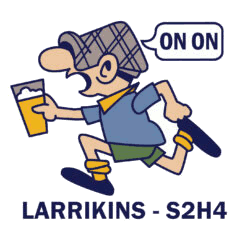Guide to Setting a Hash Run
The trailmaster has nominated you to set a run, what should you do?
The Hares should aim to set runs that last for about 60 minutes. Most Hash runners can cover between 6 & 8 kilometres over that time. Hash runs can be easily set and checked using tools such as “Map My Run”.
The running capabilities of Larrikin members varies from good to plodders to walkers. Setting a run for such a diverse group requires the Hares to give consideration to all Harriers. If you are intending to set a hard run, the use of an alternate walkers trail should be considered. Here are some suggestions for Hares when setting runs.
1/ Know where you are going before you set out Reconnoitrer the run before the run day to make the run as interesting and trouble free as possible. Try to avoid taking the trail up a hill just for the sake of it.

2/ Clearly mark the trail Use chalk arrows or flour. Should another club have recently run in the same area use different shape arrows to avoid confusion. Don’t hide the trail as it is important to give the Harriers a clear trail, properly marked especially when changing directions. The aim of the game is not to get people lost but to keep the pack together as much as possible.
3/ Use Checks & False Trails properly. Hash runs have Checks and False Trails (On Backs) to help keep the pack together. Most Checks should be set in such a way to disadvantage the faster runners and assist the plodders and walkers to keep up. False Trails are the best method of slowing down the fast runners as it brings those fast runners back to the pack. As a rule of thumb aim for 5 checks and a similar number of false trails. On Home should be marked approximately 1km from home. There should be no checks or false trails beyond this point.
Checks; the run should restart within 100 metres of the Check sign.

False Trails; go back to the last deviation in the trail and the run should restart within 100 metres of the deviation.

4/ Don’t be afraid to ask for assistance. If you are a novice Hare, don’t be afraid to ask an experienced Hare to assist in the planning and setting of the run. If you are an experienced Hare you might consider getting a new hasher to set the run with you. If you are setting the run on the day make sure to leave enough time to get back to the start before the run. This allows you to advise the Harriers of any problems i.e. crossing other trails, and also allow the novice Hare to participate in the run to see what worked and what didn’t.
5/ Don’t be a smart-arse Hare If you are going to the trouble of setting a run you want people to follow the run. If you become a smart-arse and make the run too difficult, you not only stuff up your own run but the other members of the club know to avoid your runs in the future. Surely it is better to strive to be the best Hare, not the biggest idiot. The attitude of that old saying “stuff-em they are only Hashers” should be avoided.

